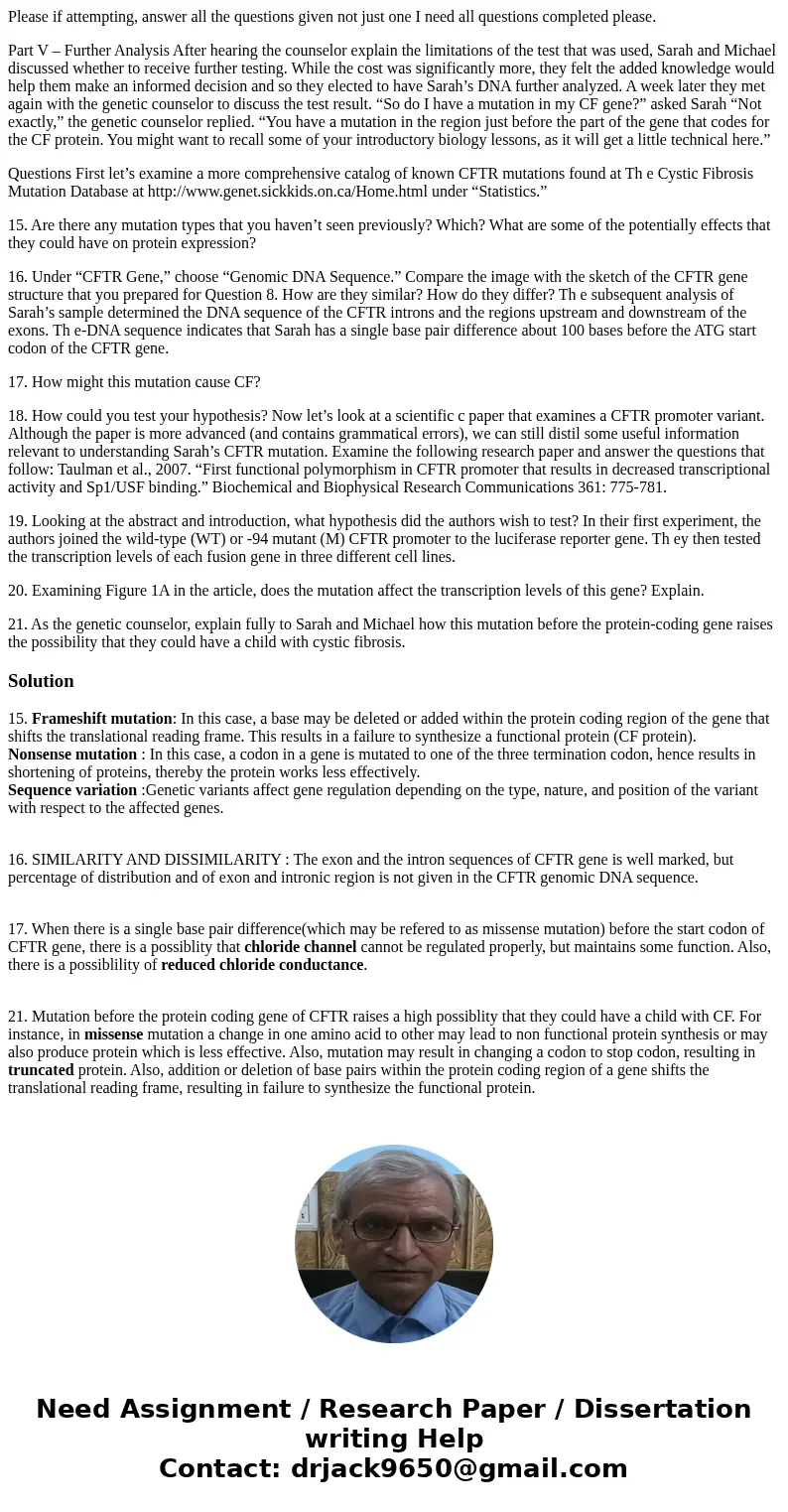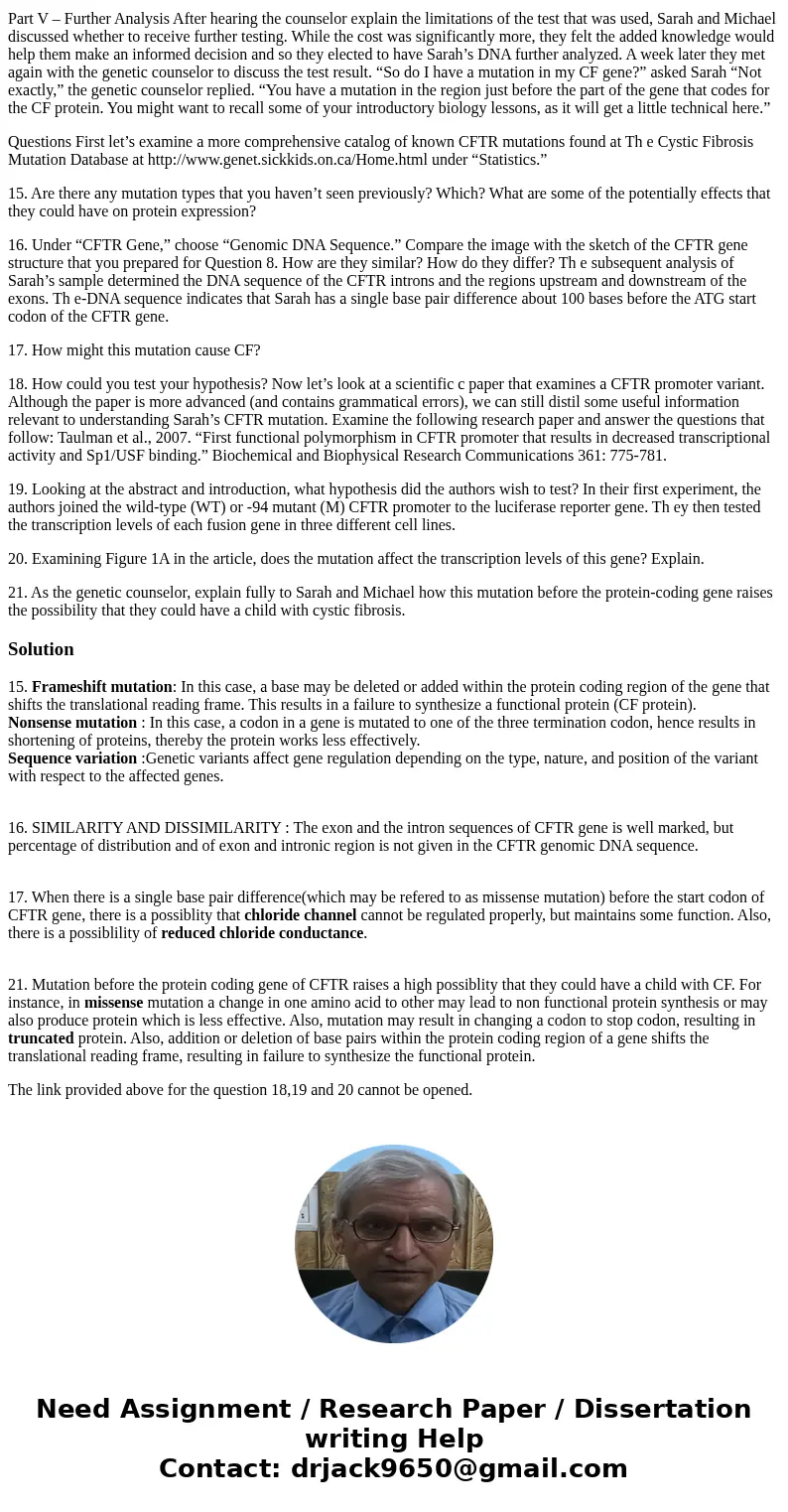Please if attempting answer all the questions given not just
Please if attempting, answer all the questions given not just one I need all questions completed please.
Part V – Further Analysis After hearing the counselor explain the limitations of the test that was used, Sarah and Michael discussed whether to receive further testing. While the cost was significantly more, they felt the added knowledge would help them make an informed decision and so they elected to have Sarah’s DNA further analyzed. A week later they met again with the genetic counselor to discuss the test result. “So do I have a mutation in my CF gene?” asked Sarah “Not exactly,” the genetic counselor replied. “You have a mutation in the region just before the part of the gene that codes for the CF protein. You might want to recall some of your introductory biology lessons, as it will get a little technical here.”
Questions First let’s examine a more comprehensive catalog of known CFTR mutations found at Th e Cystic Fibrosis Mutation Database at http://www.genet.sickkids.on.ca/Home.html under “Statistics.”
15. Are there any mutation types that you haven’t seen previously? Which? What are some of the potentially effects that they could have on protein expression?
16. Under “CFTR Gene,” choose “Genomic DNA Sequence.” Compare the image with the sketch of the CFTR gene structure that you prepared for Question 8. How are they similar? How do they differ? Th e subsequent analysis of Sarah’s sample determined the DNA sequence of the CFTR introns and the regions upstream and downstream of the exons. Th e-DNA sequence indicates that Sarah has a single base pair difference about 100 bases before the ATG start codon of the CFTR gene.
17. How might this mutation cause CF?
18. How could you test your hypothesis? Now let’s look at a scientific c paper that examines a CFTR promoter variant. Although the paper is more advanced (and contains grammatical errors), we can still distil some useful information relevant to understanding Sarah’s CFTR mutation. Examine the following research paper and answer the questions that follow: Taulman et al., 2007. “First functional polymorphism in CFTR promoter that results in decreased transcriptional activity and Sp1/USF binding.” Biochemical and Biophysical Research Communications 361: 775-781.
19. Looking at the abstract and introduction, what hypothesis did the authors wish to test? In their first experiment, the authors joined the wild-type (WT) or -94 mutant (M) CFTR promoter to the luciferase reporter gene. Th ey then tested the transcription levels of each fusion gene in three different cell lines.
20. Examining Figure 1A in the article, does the mutation affect the transcription levels of this gene? Explain.
21. As the genetic counselor, explain fully to Sarah and Michael how this mutation before the protein-coding gene raises the possibility that they could have a child with cystic fibrosis.
Solution
15. Frameshift mutation: In this case, a base may be deleted or added within the protein coding region of the gene that shifts the translational reading frame. This results in a failure to synthesize a functional protein (CF protein).
Nonsense mutation : In this case, a codon in a gene is mutated to one of the three termination codon, hence results in shortening of proteins, thereby the protein works less effectively.
Sequence variation :Genetic variants affect gene regulation depending on the type, nature, and position of the variant with respect to the affected genes.
16. SIMILARITY AND DISSIMILARITY : The exon and the intron sequences of CFTR gene is well marked, but percentage of distribution and of exon and intronic region is not given in the CFTR genomic DNA sequence.
17. When there is a single base pair difference(which may be refered to as missense mutation) before the start codon of CFTR gene, there is a possiblity that chloride channel cannot be regulated properly, but maintains some function. Also, there is a possiblility of reduced chloride conductance.
21. Mutation before the protein coding gene of CFTR raises a high possiblity that they could have a child with CF. For instance, in missense mutation a change in one amino acid to other may lead to non functional protein synthesis or may also produce protein which is less effective. Also, mutation may result in changing a codon to stop codon, resulting in truncated protein. Also, addition or deletion of base pairs within the protein coding region of a gene shifts the translational reading frame, resulting in failure to synthesize the functional protein.
The link provided above for the question 18,19 and 20 cannot be opened.


 Homework Sourse
Homework Sourse